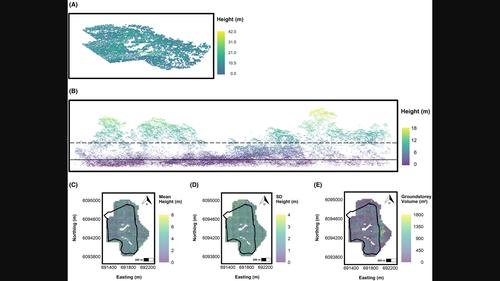利用机载激光扫描评估澳大利亚雀形目鸟类下层植被结构对巢址选择和繁殖性能的影响
IF 3.9
2区 环境科学与生态学
Q1 ECOLOGY
引用次数: 0
摘要
在野生鸟类种群中,筑巢地周围的植被结构会影响依赖后代的捕食风险2,从而导致繁殖鸟类选择具有较低捕食率的植被特征的筑巢地。然而,对于研究人员来说,在野外很难客观地量化植被结构,这可能解释了为什么人们仍然普遍缺乏对哪些特征在确定捕食率方面最重要的理解。机载激光扫描(ALS)提供了一种强大的手段,可以在不同的空间尺度上以前所未有的分辨率测量植被结构。在这里,我们将ALS与11年的8个繁殖数据结合起来,这些数据来自澳大利亚东南部的一个超级细尾鹩莺的野生种群Malurus cyaneus,这是一个筑巢相对靠近地面的物种,巢和雏鸟的捕食率很高。我们从30 x 30 11 m分辨率单元的连续网格中获得了下层植被(0-8 m)的结构测量数据,这些单元分布在我们的65公顷研究区域内。我们测试了:(i)有巢的细胞与没有巢的细胞相比,其下层植被结构特征是否存在差异;(ii)通过评估植被特征对筑巢成功率和雏鸟成活率的影响,以及随后雌性繁殖成功率的影响,这些筑巢地点的选择是适应性的。我们发现巢巢细胞与未利用的细胞的主要区别在于在下层(0-2 m;“底层”层)。17层植被的巢室平均高度也较低。18种林下植被结构特征与育种性能之间的关系较为复杂。筑巢成功率随着地面植被的增加而降低;雏鸟的存活率也是如此,尽管只有在植被较低的巢室中才有20%。繁殖成功率不受这21种因素的影响本文章由计算机程序翻译,如有差异,请以英文原文为准。

Use of Airborne Laser Scanning to assess effects of understorey vegetation structure on nest‐site selection and breeding performance in an Australian passerine bird
1 In wild bird populations, the structure of vegetation around nest-sites can influence the risk of predation 2 of dependent young offspring, generating selection for breeding birds to choose nest-sites with 3 vegetation characteristics associated with lower predation rates. However, for researchers, vegetation 4 structure can be difficult to quantify objectively in the field, which might explain why there remains a 5 general lack of understanding of which characteristics are most important in determining rates of 6 predation. Airborne Laser Scanning (ALS) offers a powerful means of measuring vegetation structure 7 at unprecedented resolution across different spatial scales. Here, we combined ALS with 11 years of 8 breeding data from a wild population of superb fairy-wrens Malurus cyaneus in south-east Australia, a 9 species which nests relatively close to the ground and has high rates of nest and fledgling predation. We 10 derived structural measurements of understorey (0-8 m) vegetation from a contiguous grid of 30 x 30 11 m resolution cells across our c. 65 hectare study area. We tested whether: (i) cells with nests differed in 12 their understorey vegetation structure characteristics compared to those without nests; and (ii) the 13 selection of these sites for nesting was adaptive, by assessing the effects of vegetation characteristics on 14 rates of nest success and fledgling survival, and the subsequent probability of a breeding female having 15 any reproductive success. We found that nest-cells differed from unused cells primarily in having denser 16 vegetation in the lowest layer of the understorey (0-2 m; the ‘groundstorey’ layer). Understorey 17 vegetation was also on average lower in height in nest-cells. However, relationships between 18 understorey vegetation structure characteristics and breeding performance were mixed. Nest success 19 rates decreased with higher volumes of groundstorey vegetation; as did fledgling survival rates, though 20 only in nest-cells with lower height vegetation. Reproductive success was not influenced by any of the 21
求助全文
通过发布文献求助,成功后即可免费获取论文全文。
去求助
来源期刊

Remote Sensing in Ecology and Conservation
Earth and Planetary Sciences-Computers in Earth Sciences
CiteScore
9.80
自引率
5.50%
发文量
69
审稿时长
18 weeks
期刊介绍:
emote Sensing in Ecology and Conservation provides a forum for rapid, peer-reviewed publication of novel, multidisciplinary research at the interface between remote sensing science and ecology and conservation. The journal prioritizes findings that advance the scientific basis of ecology and conservation, promoting the development of remote-sensing based methods relevant to the management of land use and biological systems at all levels, from populations and species to ecosystems and biomes. The journal defines remote sensing in its broadest sense, including data acquisition by hand-held and fixed ground-based sensors, such as camera traps and acoustic recorders, and sensors on airplanes and satellites. The intended journal’s audience includes ecologists, conservation scientists, policy makers, managers of terrestrial and aquatic systems, remote sensing scientists, and students.
Remote Sensing in Ecology and Conservation is a fully open access journal from Wiley and the Zoological Society of London. Remote sensing has enormous potential as to provide information on the state of, and pressures on, biological diversity and ecosystem services, at multiple spatial and temporal scales. This new publication provides a forum for multidisciplinary research in remote sensing science, ecological research and conservation science.
 求助内容:
求助内容: 应助结果提醒方式:
应助结果提醒方式:


